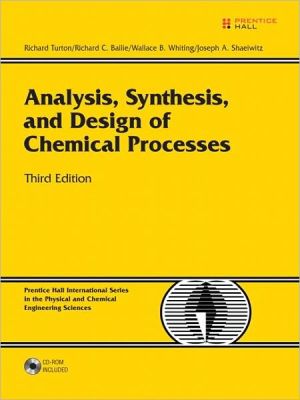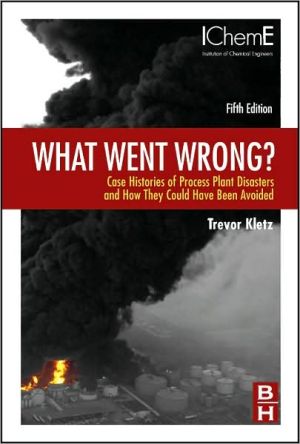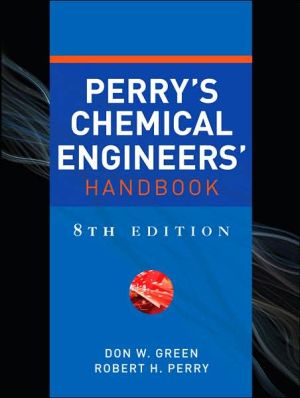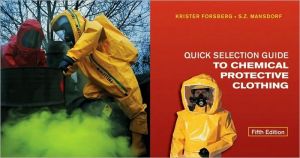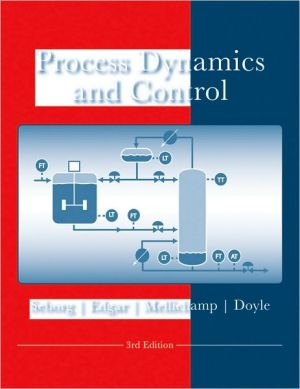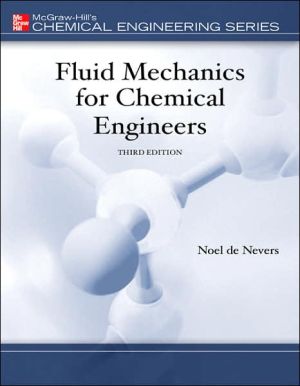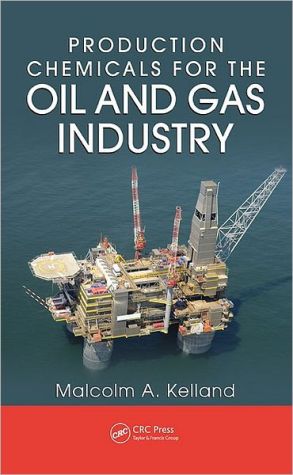Analysis Synthesis and Design of Chemical Process
The Leading Integrated Chemical Process Design Guide: Now with New Problems, New Projects, and More \ More than ever, effective design is the focal point of sound chemical engineering. Analysis, Synthesis, and Design of Chemical Processes, Third Edition, presents design as a creative process that integrates both the big picture and the small details—and knows which to stress when, and why. Realistic from start to finish, this book moves readers beyond classroom exercises into open-ended,...
Search in google:
The Leading Integrated Chemical Process Design Guide: Now with New Problems, New Projects, and MoreMore than ever, effective design is the focal point of sound chemical engineering. Analysis, Synthesis, and Design of Chemical Processes, Third Edition, presents design as a creative process that integrates both the big picture and the small details—and knows which to stress when, and why. Realistic from start to finish, this book moves readers beyond classroom exercises into open-ended, real-world process problem solving. The authors introduce integrated techniques for every facet of the discipline, from finance to operations, new plant design to existing process optimization.This fully updated Third Edition presents entirely new problems at the end of every chapter. It also adds extensive coverage of batch process design, including realistic examples of equipment sizing for batch sequencing; batch scheduling for multi-product plants; improving production via intermediate storage and parallel equipment; and new optimization techniques specifically for batch processes.Coverage includesConceptualizing and analyzing chemical processes: flow diagrams, tracing, process conditions, and moreChemical process economics: analyzing capital and manufacturing costs, and predicting or assessing profitability Synthesizing and optimizing chemical processing: experience-based principles, BFD/PFD, simulations, and moreAnalyzing process performance via I/O models, performance curves, and other toolsProcess troubleshooting and “debottlenecking”Chemical engineering design and society: ethics, professionalism, health, safety, and new “green engineering” techniquesParticipating successfully in chemical engineering design teamsAnalysis, Synthesis, and Design of Chemical Processes, Third Edition, draws on nearly 35 years of innovative chemical engineering instruction at West Virginia University. It includes suggested curricula for both single-semester and year-long design courses; case studies and design projects with practical applications; and appendixes with current equipment cost data and preliminary design information for eleven chemical processes—including seven brand new to this edition.About the CD-ROMThe CD-ROM contains the latest version of CAPCOST, a powerful tool for evaluating fixed capital investment, full process economics, and profitability—now expanded with cost data for conveyors, crystallizers, dryers, dust collectors, filters, mixers, reactors, and screens. It also contains the HENSAD tool for constructing temperature interval, cascade, and temperature enthalpy diagrams; estimating optimal approach temperatures; and designing heat exchanger networks. Also provided: additional chapters on outcomes assessment, written and oral communications, and a written report case study, as well as six complete student design projects. Booknews Focuses on process design as the focal point of chemical engineering practice. Covers chemical process diagrams, engineering economic analysis of chemical processes, technical analysis of chemical processes, analysis of system performance, synthesis and optimization of a process flow diagram, professional engineering standards, environmental concerns, and communication issues. The included CD-ROM contains CAPCOST, a Windows-based program for estimating the fixed capital cost of a process. By entering capacity, operating pressure, and materials of construction data for all major process equipment, the total installed cost of a chemical process can be estimated. Annotation c. by Book News, Inc., Portland, Or.
Preface Preface\ This book represents the culmination of many years of teaching experience in the senior design course at West Virginia University (WVU) and University of Nevada, Reno. Although the program at WVU has evolved over the past 30 years and is still evolving, it is fair to say that the current program has gelled over the past 20 years as a concerted effort by the authors to integrate design throughout the undergraduate curriculum in chemical engineering.\ We view design as the focal point of chemical engineering practice. Far more than the development of a set of specifications for a new chemical plant, design is the creative activity through which engineers continuously improve the operations of facilities to create products that enhance the quality of life. Whether developing the grassroots plant, proposing and guiding process modifications, or troubleshooting and implementing operational strategies for existing equipment, engineering design requires a broad spectrum of knowledge and intellectual skills to be able to analyze the big picture and the minute details and, most important, to know when to concentrate on each.\ Our vehicle for helping students develop and hone their design skills is process design rather than plant design, covering synthesis of the entire chemical process through topics relating to the preliminary sizing of equipment, flowsheet optimization, economic evaluation of projects, and the operation of chemical processes. The purpose of this text is to assist chemical engineering students in making the transition from solving well-posed problems in a specific subject to integrating all the knowledge that they have gained in their undergraduate education and applying this information to solving open-ended process problems. Many of the nuts-and-bolts issues regarding plant design (for example, what schedule pipe to use for a given stream or what corrosion allowance to use for a vessel in a certain service) are not covered. Although such issues are clearly important to the practicing engineer, several excellent handbooks and textbooks are available to address such problems, and these are cited in the text where applicable.\ In the third edition, we have rearranged some of the material from previous editions, added a new chapter on batch processing and a section on optimization of batch processes, and supplied new problems for all of the quantitative chapters. We continue to emphasize the importance of understanding, analyzing, and synthesizing chemical processes and process flow diagrams. To this end, we have expanded Appendix B to include an additional seven preliminary designs of chemical processes. The CAPCOST program for preliminary evaluation of fixed capital investment and profitability analysis has been expanded to include more equipment. Finally, the chapters on outcomes assessment, written and oral communications, and a written report case study have been moved to the CD accompanying the text.\ The arrangement of chapters into the six sections of the book is similar to that adopted in the second edition. These sections are as follows.\ \ Section 1—Conceptualization and Analysis of Chemical Processes\ Section 2—Engineering Economic Analysis of Chemical Processes\ Section 3—Synthesis and Optimization of Chemical Processes\ Section 4—Analysis of Process Performance\ Section 5—The Impact of Chemical Engineering Design on Society\ Section 6— Interpersonal and Communication Skills\ \ In Section 1, the student is introduced first to the principal diagrams that are used to describe a chemical process. Next, the evolution and generation of different process configurations are covered. Key concepts used in evaluating batch processes are included in the new Chapter 3, and the chapter on product design has been moved to Chapter 4. Finally, the analysis of existing processes is covered.\ In Section 2, the information needed to assess the economic feasibility of a process is covered. This includes the estimation of fixed capital investment and manufacturing costs, the concepts of the time value of money and financial calculations, and finally the combination of these costs into profitability measures for the process.\ Section 3 covers the synthesis of a chemical process. The minimum information required to simulate a process is given, as are the basics of using a process simulator. The choice of the appropriate thermodynamic model to use in a simulation is covered, and the choice of separation operations is covered. In addition, process optimization (including an introduction to optimization of batch processes) and heat integration techniques are covered in this section.\ In Section 4, the analysis of the performance of existing processes and equipment is covered. The material in Section 4 is substantially different from that found in most textbooks. We consider equipment that is already built and operating and analyze how the operation can be changed, how an operating problem may be solved, and how to analyze what has occurred in the process to cause an observed change.\ In Section 5, the impact of chemical engineering design on society is covered. The role of the professional engineer in society is addressed. Separate chapters addressing ethics and professionalism, health, safety, and the environment, and green engineering are included.\ In Section 6, the interpersonal skills required by the engineer to function as part of a team and to communicate both orally and in written form are covered (both in the text and on the CD). An entire chapter (on the CD) is devoted to addressing some of the common mistakes that students make in written reports.\ Finally, three appendices are included. Appendix A gives a series of cost charts for equipment. This information is embedded in the CAPCOST program for evaluating fixed capital investments and process economics. Appendix B gives the preliminary design information for 11 chemical processes: dimethyl ether, ethylbenzene, styrene, drying oil, maleic anhydride, ethylene oxide, formalin, batch manufacture of amino acids, acrylic acid, acetone, and heptenes production. This information is used in many of the end-of-chapter problems in the book. These processes can also be used as the starting point for more detailed analyses—for example, optimization studies. Other projects, detailed in Appendix C, are included on the CD accompanying this book. The reader (faculty and students) is also referred to our Web site at che.cemr.wvu.edu/publications/projects/, where a variety of design projects for sophomore- through senior-level chemical engineering courses is provided. There is also a link to another Web site that contains environmentally related design projects.\ For a one-semester design course, we recommend including the following core:\ \ Section 1—Chapters 1 through 6\ Section 3—Chapters 11, 12, and 13\ Section 5—Chapters 23 and 24\ \ For programs in which engineering economics is not a prerequisite to the design course, Section 2 (Chapters 7–10) should also be included. If students have previously covered engineering economics, Chapters 14 and 15 covering optimization and pinch technology could be substituted.\ For the second term of a two-term sequence, we recommend Chapters 16 through 20 (and Chapters 14 and 15 if not included in the first design course) plus design projects. If time permits, we also recommend Chapter 21 (Regulating Process Conditions) and Chapter 22 (Process Troubleshooting) because these tend to solidify as well as extend the concepts of Chapters 16 through 20, that is, what an entry-level process engineer will encounter in the first few years of employment at a chemical process facility. For an environmental emphasis, Chapter 25 could be substituted for Chapters 21 and 22; however, it is recommended that supplementary material be included.\ We have found that the most effective way both to enhance and to examine student progress is through oral presentations in addition to the submission of written reports. During these oral presentations, individual students or a student group defends its results to a faculty panel, much as a graduate student defends a thesis or dissertation.\ Because design is at its essence a creative, dynamic, challenging, and iterative activity, we welcome feedback on and encourage experimentation with this design textbook. We hope that students and faculty will find the excitement in teaching and learning engineering design that has sustained us over the years.\ Finally, we would like to thank those people who have been instrumental to the successful completion of this book. Many thanks are given to all undergraduate chemical engineering students at West Virginia University over the years, particularly the period 1992–2008. In particular, we would like to thank Joe Stoffa, who was responsible for developing the spreadsheet version of CAPCOST, and Mary Metzger and John Ramsey, who were responsible for collecting and correlating equipment cost information for this edition. We also acknowledge the many faculty who have provided, both formally and informally, feedback about this text. Finally, RT would like to thank his wife Becky for her continued support, love, and patience during the preparation of this third edition.\ R.T.\ R.C.B.\ W.B.W.\ J.A.S.\ © Copyright Pearson Education. All rights reserved.
PrefaceList of NomenclatureOutcomes Assessment1Sect. 1Conceptualization and Analysis of Chemical Processes9Ch. 1Diagrams for Understanding Chemical Processes11Ch. 2The Structure and Synthesis of Process Flow Diagrams57Ch. 3Tracing Chemicals through the Process Flow Diagram99Ch. 4Understanding Process Conditions115Sect. 2Engineering Economic Analysis of Chemical Processes141Ch. 5Estimation of Capital Costs143Ch. 6Estimation of Manufacturing Costs187Ch. 7Engineering Economic Analysis221Ch. 8Profitability Analysis261Sect. 3Synthesis and Optimization of Chemical Processes325Ch. 9Utilizing Experience-Based Principles of Confirm the Suitability of a Process Design327Ch. 10Synthesis of the PFD from the Generic BFD354Ch. 11Synthesis of a Process Using a Simulator and Simulator Troubleshooting384Ch. 12Process Optimization424Ch. 13Pinch Technology459Sect. 4Analysis of Process Performance519Ch. 14Process Input/Output Models523Ch. 15Tools for Evaluating Process Performance532Ch. 16Performance Curves for Individual Unit Operations548Ch. 17Performance of Multiple Unit Operations593Ch. 18Reactor Performance625Ch. 19Regulating Process Conditions661Ch. 20Process Troubleshooting and Debottlenecking697Sect. 5The Impact of Chemical Engineering Design on Society729Ch. 21Ethics and Professionalism731Ch. 22Health, Safety, and the Environment770Ch. 23Green Engineering804Ch. 24Chemical Product Design818Sect. 6Interpersonal and Communication Skills831Ch. 25Teamwork833Ch. 26Written and Oral Communications857Ch. 27A Report Writing Case Study885App. ACost Equations and Curves for the CAPCOST Program915App. BInformation for the Preliminary Design of Four Chemical Processes938App. CDesign Projects (on companion CD-ROM)Index977
\ BooknewsFocuses on process design as the focal point of chemical engineering practice. Covers chemical process diagrams, engineering economic analysis of chemical processes, technical analysis of chemical processes, analysis of system performance, synthesis and optimization of a process flow diagram, professional engineering standards, environmental concerns, and communication issues. The included CD-ROM contains CAPCOST, a Windows-based program for estimating the fixed capital cost of a process. By entering capacity, operating pressure, and materials of construction data for all major process equipment, the total installed cost of a chemical process can be estimated. Annotation c. by Book News, Inc., Portland, Or.\ \
